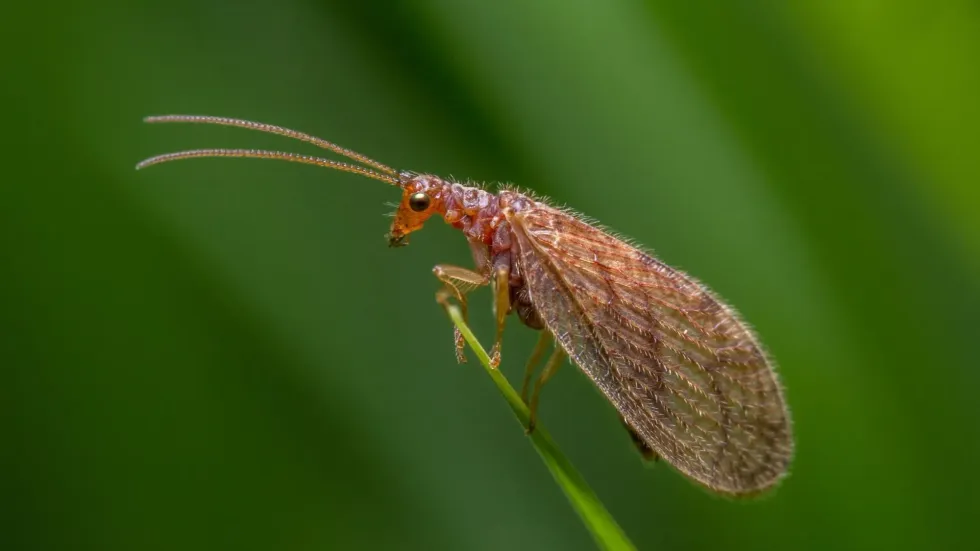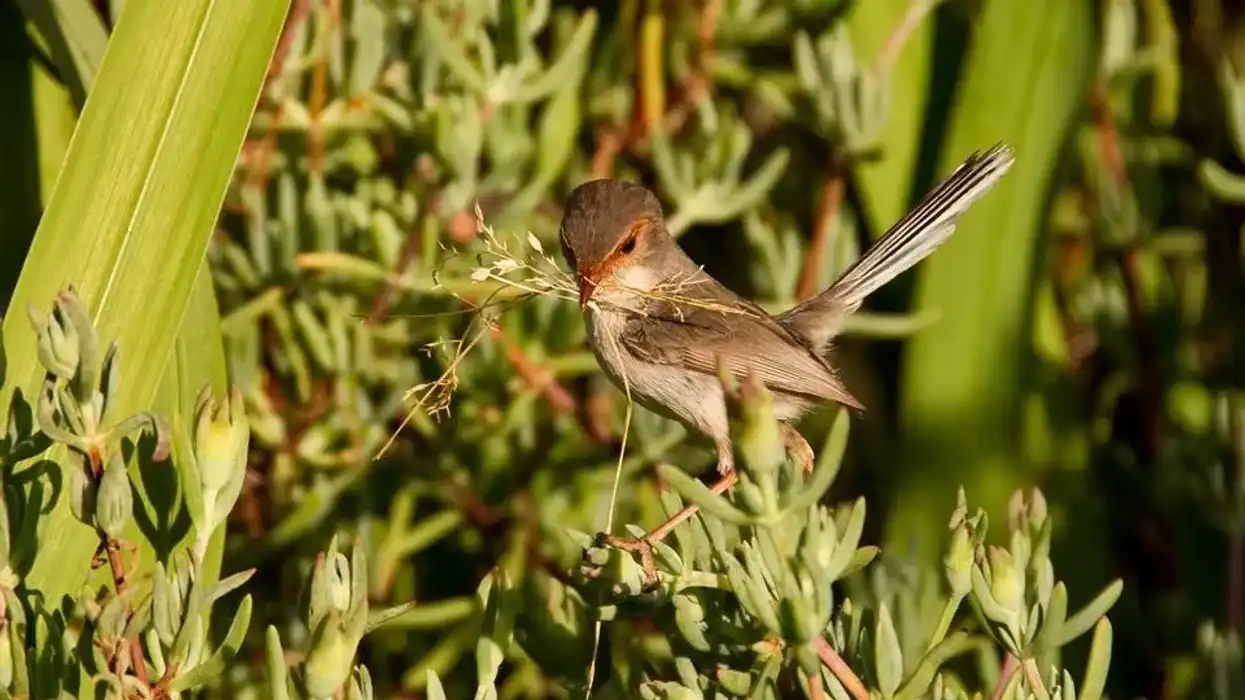Brown lacewing is a family of predatory insects that consist of 28 genera and 500 species. All the insects that make up the family Hemerobiidae are called brown lacewings. A similar species to brown lacewings, green lacewings belong to the family Chrysopidae and they are not even closely related to brown lacewings.
Both the adult and the larvae of these insects are predaceous in nature. The predatory nature has given them the title of agricultural pests control. The larvae feed on soft-bodied pests like mites, aphids, and psyllid.
The life cycle of brown lacewings, like green lacewings, is also divided into four stages. They are eggs-larva-pupa-adult brown lacewing.
Unlike green lacewings that lay their eggs attached to the stalk of plants, brown lacewing eggs are laid on the leaves. Except for the first instar stage, brown lacewing larvae are immobile in the rest of the instars. The larvae find a protected place for them to pupate.
They develop a thread cocoon around themselves from which the adults emerge after a few days. To know more facts about these insects, keep on reading these facts.
For similar content check out green stink bug and ghost ant.
Brown Lacewing Interesting Facts
What type of animal is a brown lacewing?
The brown lacewing is a large family of insects.
What class of animal does a brown lacewing belong to?
Brown lacewings of order Neuroptera and family Hemerobiidae belong to the class Insecta, the common class for all insects.
How many brown lacewings are there in the world?
The global population of brown lacewings has not been determined currently. The distribution of lacewings all over the world makes it difficult to quantify their population. As a result, very little data exists regarding the population description of the insect.
Lacewings have a fairly large population all over the world. They are observed commonly in various places either as adults or as larvae.
Accordingly, the population is also considered to be large. The population trend of lacewings is stable with no indications of population fluctuations. The population is not severely fragmented and they exist without any significant threat
Where does a brown lacewing live?
The brown lacewing is a superfamily of several species found in different parts of the world. There are more than 500 types of brown lacewings and 60 of them occur in the United States.
Some of them are also native to Europe. For example, the species Hemerobius azoricus of the Hemerobius genus is native to Portugal in Europe while the species Micromus subanticus and Sympherobius amiculus of Micromus and Sympherobius genera are found in Florida.
What is a brown lacewing's habitat?
The brown lacewing habitat ranges from native forests to urban gardens. The insect has the ability to inhabit any type of habitat that contains their preferred food items like aphids and mites.
They can be found in disturbed habitats like gardens and meadows but mostly they are found in shrubland and in exotic forest trees. They are nocturnal and hide in the canopy at night to prey on soft-bodied insects.
They avoid places with hot summers and are most active during winter and spring.
In dry and hot places like in California, brown lacewings prefer to live in coastal habitats rather than arid interiors. It is rare to find an adult brown lacewing in house, sometimes the larvae might get in from houseplants.
Who does brown lacewing live with?
Brown lacewings do not live with any other individual, they are solitary. However, these insects often are found in small swarms when they fly.
How long does a brown lacewing live?
The lifespan of the insects of Hemerobiidae families, like brown and green lacewings, ranges between four to six weeks of age. However, there is a single brown lacewing called Hemerobius pacificus that can live up to 10 weeks and are capable of producing more eggs because of their longer lifespan.
How do they reproduce?
Brown lacewings do not have any particular breeding season. It is a short-lived insect that starts to breed as soon as they enter the adult brown lacewing stage from being a larva. However, in places with freezing winters they become inactive in the winter season.
Adult brown lacewings lay eggs on low plants. Females can lay up to 100-150 eggs in their entire life. In California, brown lacewing adults can lay 600-700 eggs.
The eggs are laid in clusters. The life cycle of brown lacewing larvae goes through three stages of instar. Both larvae and adults feed on aphids as their primary source of nourishment.
What is their conservation status?
Brown lacewings of the Hemerobiidae family are classified as a species of Least Concern in the IUCN Red List. A large population of brown lacewing adults and larvae are found in many places of the world.
Brown lacewings like green lacewings are subdivided into several genera and species. Not all species are concentrated in the same region. A never-ending source of food for predaceous adults and larvae has also helped the population of brown lacewings to grow.
Brown lacewings have biological importance in controlling pests as the prey of aphids, mites, and several other pests. There are some records of population decline in the past due to habitat fluctuations.
Brown Lacewing Fun Facts
What does the brown lacewing look like?
The identification characteristics of the adult brown lacewing vary widely from the physical description of the larvae. Adults have dark to light brown bodies with two membranous oval-shaped wings. The wings are held on the top of the body like a roof when the wings are at rest. Some of them have spotted bodies with black and yellow colors.
The wings are dark to light brown in color. The network of veins is easily observed through the wings. The larvae are flat with a tapering tail and distinct tails.
How cute are they?
Brown lacewings do not naturally appear as cute to humans.
How do they communicate?
Lacewings communicate by body vibration, especially during the time of reproduction.
How big is a brown lacewing?
The length of a brown lacewing ranges up to 0.4 in (1 cm). They are similar in size to lace bugs.
How fast can brown lacewing move?
Brown lacewing larvae are immobile in their last two instars but the adults can fly. Their speed is unknown.
How much does a brown lacewing weigh?
The weight of brown lacewings is unknown.
What are the male and female names of the species?
Male and female lacewings do not have any specific names, both are called brown lacewings.
What would you call a baby brown lacewing?
A brown lacewing in its larval stage is called larvae.
Are they harmful?
Brown and green lacewings are beneficial and they are important in biological control. Brown lacewings prey on pests like aphids, mealybugs, and whiteflies and help in controlling them.
Would they make a good pet?
No, brown lacewings do not make good pets. Apart from that, they can inflict painful bites on humans.
Did you know...
Green lacewings have more veins than brown lacewings. The large network of long veins and some cross veins helps in the identification of a green lacewing from a born lacewing.
Naming The Brown Lacewing
Brown lacewings have a dark to light brown body and wings. Therefore, they are called brown lacewings.
Are lacewings harmful?
The relatively large brown lacewing is harmful to tiny mites since they prey on them. In rare cases, they bite humans but a brown lacewing bite does not cause any major issue more than skin irritation in the body.
Here at Kidadl, we have carefully created lots of interesting family-friendly animal facts for everyone to discover! For more relatable content, check out these ladybird facts and stick bug facts for kids.
You can even occupy yourself at home by coloring in one of our free printable forest bug coloring pages.
Second image by Jacy Lucier









